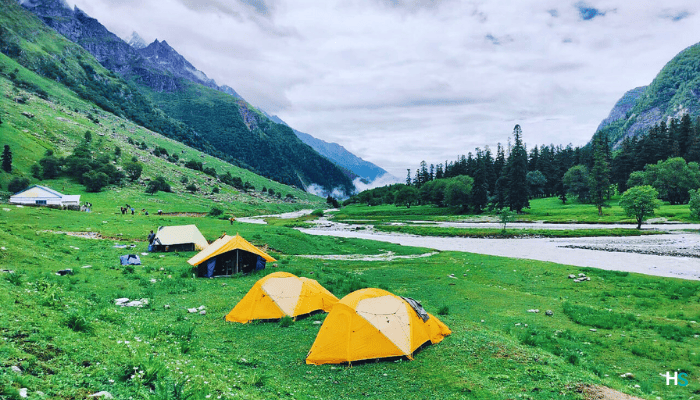
Dainkund Peak Trek
TREK DIFFICULTY
Easy
TREK DURATION
1 Days
HIGHEST ALTITUDE
9,039 Feet
GROUP SIZE
12
TREK DISTANCE
10 Km
BASECAMP
Himachal Pradesh
BEST TIME
March to June
PICKUP POINT
Himachal Pradesh
Dainkund Peak Trek
Dainkund Peak, also known as a 'Singing Hill' is the highest peak located in Dalhousie, Himachal Pradesh. It stands at the elevation of 2,755 m above sea level and offers breathtaking views of famous Himalayan ranges. It's a short and easy trek, well-suitable for beginners and families.
It is surrounded by the Himalayan peaks and dense forests of oak, deodar and pine. The wind passes through the forests, creates a melodious sound, this is why it is called a Singing Hill.
The trek starts from Lakkar Mandi which is around 8 km from Dalhousie. From here the trail is about 3.5 km long and takes up to 2 hours to complete. The path is well-paved and well-marked, not too steepy, nor too rocky. You will pass through beautiful forests and alpine meadows, blooming in the summer season.
The main highlight of the trek is Pholani Devi Temple at the top. It is very popular among tourists. It's small but holds high spiritual value. Trekkers often stop by and offer their prayers here.
Dainkund is an ideal trek for beginners. Experienced trekkers also do it for its spiritual significance and natural beauty. The best time to do a trek is from March to June and in September-October. The trek offers a perfect blend of simplicity and adventure, and leaves you more refreshed and amazed by the views.
History of Dainkund Peak Trek
Dainkund, the highest point in Dalhousie, Himachal Pradesh holds great spiritual and mythological significance. The name 'Dainkund' means 'dain' (a witch) and kund means 'pond' in Hindi. There's a famous mythological story associated with this peak.
According to folklore, once a witch used to live in the region who used to haunt innocent villagers. It disturbed the peace of the village. Oppressed and haunted by her, they prayed to a deity who was an incarnation of Goddess Kali. The deity defeated the witch and brought harmony back to the village. To honour the deity, villagers built a small temple, the Pohlani Mata Temple near the summit. Even today, this temple holds high religious and spiritual significance and protects the locals.
The Dainkund Peak region has been popular with spiritual refugees and local shepherds. It was served as a grazing land by the local shepherds community. When invaders and foreign rulers came to India, they didn't affect this region due to its remote and forested terrain. Locals tell that many sages and saints meditated here in its isolated and pristine environment to seek divine grace and salvation.
Around 1971, the Indian Air Force established a radar station near the peak. This station was set up to enhance communication and air defense coverage in the Himalayas, particularly for the Dalhousie region. Today, the Dainkund Peak region is popular among tourists and trekkers for its natural beauty and spiritual bliss.
Highlights of Dainkund Peak Trek
360° Views of Famous Mountains: Dainkund Peak is located at 2,750 m above sea level. It is the highest point in Dalhousie. From the top, you can see the amazing views of snow-covered Pir Panjal range, Dhauladhar range, Bhandal valley and even a glimpse of Ravi river flowing through the hills. Viewing all this Himalayan phenomenon will make your day.
Pholani Devi Temple: Pholani Devi Temple is small but very popular temple near the peak. There are few mythological stories associated with it. It holds a high spiritual value among locals and tourists. Interestingly, there's no idol inside the temple, only a trident (trishul) is enshrined. Tourists and trekkers visit this temple and offer their prayers to the deity.
The Singing Hill: Dainkund Peak is often called a 'Singing Hill' or 'Whistling Hill' due to the sound of wind passing through hills. There are dense forests of deodar, oak and pine through which wind passes. It creates a melodious sound which enchants tourists and makes it a tranquil place.
A Trek Perfect for All: The Dainkund Peak trek is popular for its accessibility for all age groups. Kids (and 6), families, beginners and even elderly people can do this trek. It is short and it has everything for all, fun for kids, adventure for youngsters, spirituality and peace for olders and beauty for nature lovers. The trail is well-paved and well-marked so the problem of navigation doesn't occur.
Snow in Winter Months: During winter, the trail is covered with snow which converts Dainkund to a white land. The snowy landscape looks magical and dreamy. It offers a wonderful scenario for snow lovers.
Difficulty Level of the Dainkund Peak Trek
Dainkund Peak trek is a short and beginner-friendly trek, suitable for kids (above 6 years), families and solo trekkers. It is relatively an easy trek with total trek duration, including return and rest, is about 3 to 4 hours (3-4 km). The trek starts in Lakkar Mandi and heads to Dainkund Peak trek, situated at an elevation of approx 2,755 m above sea level.
The trail of Dainkund Peak trek is well-paved and well-marked alongside pine and deodar forests. The trail includes gradual ascents and flat patches but nothing technically challenging. The terrain is a mix of grassland, forests and rocks.
The best thing about Dainkund Peak trek is, you can do it with your families and kids (above 6 years). Solo trekkers can also attempt it, no prior trekking experience and particular guidance is needed. However, climbing the staircase of Pholani Devi Temple at the summit can make it slightly challenging for elders or those with knee issues.
In monsoon, the trail can be slippery and in winter it can be snow-covered so it requires caution. The best time to do this trek is in the spring, summer and autumn seasons.
Overall, Dainkund Peak trek is an easy and short trek which gives a fulfilling Himalayan hiking experience. If you just want to start your trekking journey and are looking for an easy one, you can choose it.
Best Time to Visit Dainkund Peak Trek
Though the Dainkund Peak trek is all seasoned trek, the ideal time to do it is from March to June and from September to November. During these months, the weather is pleasant and the sky is clear.
- March to June (Spring & Summer): Arrival of spring makes the trail alive and by the summer, the trail is full of greenery. The weather is perfect and temperature ranges go between 15°C to 25°C. Clear sky makes the Dhauladhar and Pir Panjal ranges visible. The panoramic views of surrounding valleys are at their best.
- July-August (Monsoon): Heavy rainfall can make the trail slippery and prone to landslides. Thus this window is not recommended to do the Dainkund Peak trek but adventure seekers can attempt it with caution.
- September to November (Autumn): Post-monsoon freshness adds charm to the surroundings. Sky is also clear. The golden hue of autumn makes trails dreamy; perfect for photography. The temperature ranges are between 10°C to 20°C.
- December to February (Winter): This time trails can be covered with snow which are not suitable for families and kids. Temperature can also drop below 0°C. Due to harsh weather better avoid this window to trek.
How to Reach Dainkund Peak Trek
Dainkund Peak is located near Dalhousie town in Himachal Pradesh. It is an easy, accessible and short trek.
To trek to Dainkund Peak, first reach Dalhousie. You can take a train or bus to Pathankot which is the nearest railway station and bus terminal. Pathankot is about 80 km away from Dalhousie. You can also take a flight for Pathankot Airport or Gaggal (Kangra) Airport to reach Dalhousie.
From Pathankot, taxis and local buses are available to Dalhousie which takes around 3 hrs to reach.
On reaching Dalhousie, take a taxi or local bus to reach Lakkar Mandi. Lakkar Mandi is a small village, located 8 km away from Dalhousie. It serves as a base camp or starting point to Dainkund Peak trek.
From Lakkar Mandi, you can start your trek to Dainkund Peak. The trek is about 4.5 km long and takes typically 2-3 hrs to reach (one way). The trail is well-marked and well-paved, passing through deodar and pine forests.
You can also visit the popular Pholani Devi Temple en route which is a common stop during the trek. The trek is accessible year-round, except during heavy snowfall in peak winter.
Day 1: Arrival at Dalhousie – Drive to Lakkad Mandi – Trek to Dainkund Peak – Return to Dalhousie
Arrive in Dalhousie early morning
Drive to Lakkad Mandi (starting point of the trek) – about 10 km from Dalhousie
Start trek from Lakkar Mandi to Dainkund Peak (2,755 m)
Trek duration: 2 to 3 hours (easy trail, gradual ascent)
Explore the peak and enjoy panoramic views of Pir Panjal range
Visit Pholani Devi Temple on the ridge
Descend back to Lakkad Mandi
Drive back to Dalhousie by evening
In Himalaya Shelter, we provide you with the option to customize your Dainkund Peak trekking experience. Whether you're a beginner, solo traveller or a group of friends, you can opt for our personalized tailor-made trekking program. This customized trek will be exclusively designed for you, taking into account your specific requirements for transportation, accommodation, meals and any other premium facilities you may need during the trek.
Starting from Lakkar Mandi, a small village near Dalhousie, Dainkund Peak trek's trail passes through pine and deodar forests and offers scenic views. Himalaya Shelter ensures your journey is safe and memorable with experienced local guides and all necessary permits. You can even request offbeat routes or sunrise hikes for a more immersive Himalayan experience.
Moreover, no other participants will be added to your group. Choosing a customized trek will enable you to fully enjoy the trek with your loved ones.
Day 1: Dalhousie to Dainkund peak via Lakkad Mandi; and back to Dalhousie | Drive: 18 km in 30 min.; Trek: 10 km in 5 - 6 hrs
Our treks are specially designed by the experienced team at Himalaya Shelter taking you on an adventure of a lifetime all while making you connect not only with the bountiful nature but also with yourself and with others on the trek with you creating wonderful memories which will last you a lifetime. All Himalaya Shelter treks are guided by experienced Trekkers having vast knowledge and experience of the region, providing with insightful information and stories pertaining to the region’s flora and fauna and the history of the region whilst the trek. It is safe to say that on successfully completing the trek one will gain tremendous insight and experience along with lifetime memories.
Inclusions
- Transport Support from Drive to Lakkad Mandi (starting point of the trek) – about 10 km from Dalhousie
- Lunch: Vegetarian Meal
- Professional Guide
- First-Aid kit
- All applicable taxes
Exclusions
- Personal expenses like tips, personal medicines, phone calls etc.
- Any cost or services not mentioned in the Inclusions
- Accommodation in Dalhousie
Keeping the Himalayas clean is our own responsibility. Reduce the use of Plastic when you are in the abode of the Sacred Himalaya. 🌱
Dainkund Peak is near Dalhousie in Himachal Pradesh.
Around 2,750 meters (9,000 feet) above sea level.
The trek is about 4–5 km one way.
Easy to moderate; suitable for beginners and families.
Not mandatory; the trail is well-marked.
March to June and September to December.
Yes, it’s suitable for kids above 6 years.
2–3 hours (one way), depending on pace.
The trek usually starts from Lakkar Mandi near Dalhousie.
No, only at the base or near villages.
Yes, partial coverage (mainly Jio, Airtel).
No, camping is generally not permitted.
No, carry your own snacks and water.
A mix of forest patches and open meadows.
Yes, if they are fit and healthy.
Read More on Dainkund Peak Trek
Treks by Categories
Treks By Month

Treks By Experience





